A Day in the Life of Jacqueline
When I initially borrowed Jacqueline, I was not sure whether I would actually use the bicycle for transportation, or just ride a bit in my spare time. But after half a day, I decided not to renew my weekly public transport card for the duration of my stay in Vienna. It is very easy to get around the city by bicycle - not just through the central touristy parts, but through Vienna proper. To demonstrate, Jacqueline will show you one of her daily routines.
 At 7:00 am, we are off to the office via the Danube Canal Path - which functions like a cross-town bicycle highway through Vienna. It just so happens that both my flat and my office are close to the canal, so our route to work is pretty straightforward. Pictured above is the nearest entrance onto the path.
At 7:00 am, we are off to the office via the Danube Canal Path - which functions like a cross-town bicycle highway through Vienna. It just so happens that both my flat and my office are close to the canal, so our route to work is pretty straightforward. Pictured above is the nearest entrance onto the path.
 The Danube Canal is an offshoot of the Danube River. Both the canal and the river proper have bicycle paths running alongside, but the advantage of he canal path is that it cuts through the center.
The Danube Canal is an offshoot of the Danube River. Both the canal and the river proper have bicycle paths running alongside, but the advantage of he canal path is that it cuts through the center.
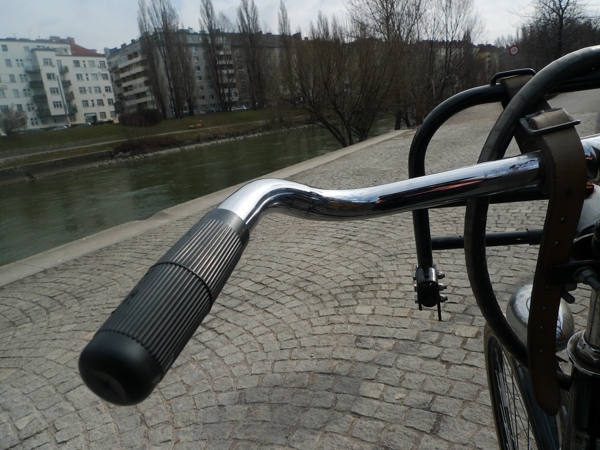 One thing I like about it, is how green the water looks - especially in the morning. No idea whether this is due to reflection from trees or chemical pollution, but it looks nice and so I choose to believe the former.
One thing I like about it, is how green the water looks - especially in the morning. No idea whether this is due to reflection from trees or chemical pollution, but it looks nice and so I choose to believe the former.
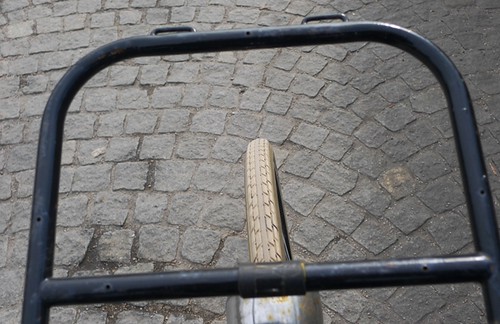 There are some cobblestone stretches along the path, and the 28" Schwalbe Delta Cruisers on Jacqueline are just fine with them. But I have seen other cyclists get off their bikes and walk here.
There are some cobblestone stretches along the path, and the 28" Schwalbe Delta Cruisers on Jacqueline are just fine with them. But I have seen other cyclists get off their bikes and walk here.
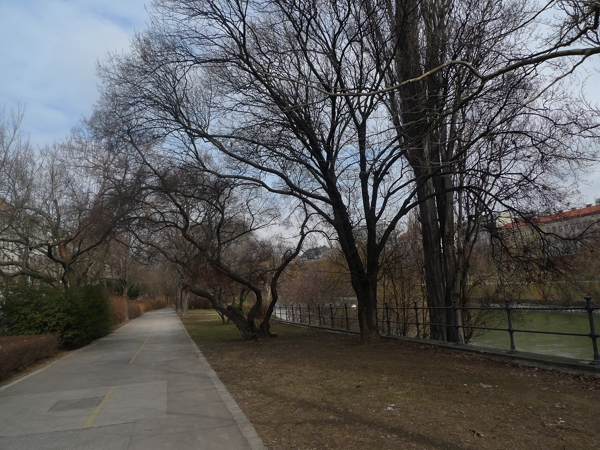 Some parts of the canal path are woodsy and surreal-looking.
Some parts of the canal path are woodsy and surreal-looking.
 Jacqueline enjoys this sort of scenery the most.
Jacqueline enjoys this sort of scenery the most.
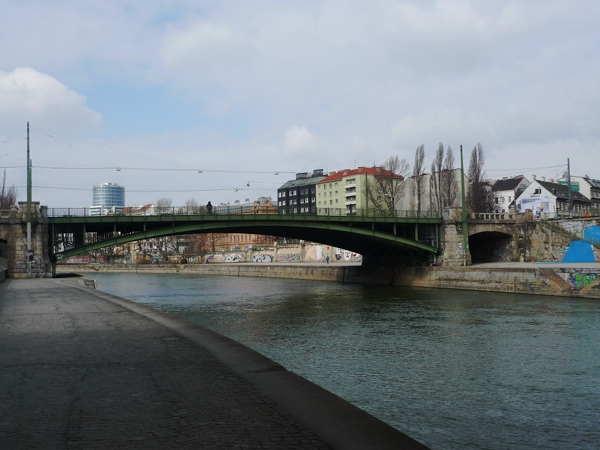 Other stretches are more urban and take you closer to the main road.
Other stretches are more urban and take you closer to the main road.
 That's okay too, but cycling here during rush hour will give you a nice helping of auto exhaust fumes. Have others noticed this problem in large cities? I have been told that automobile emissions in Europe (not counting former Eastern-bloc countries) are supposed to be less toxic than in the US, but my lungs seem to disagree. If anybody has more info about this, please share.
That's okay too, but cycling here during rush hour will give you a nice helping of auto exhaust fumes. Have others noticed this problem in large cities? I have been told that automobile emissions in Europe (not counting former Eastern-bloc countries) are supposed to be less toxic than in the US, but my lungs seem to disagree. If anybody has more info about this, please share.
 Heading toward the Southern edge of town, the scenery on the Danube Canal Path grows distinctly less picturesque. We are now cycling alongside the highway. And yes, that is a highway sign for Budapest and Bratislava. Bratislava (capital of Slovakia) is only a 45 minute drive away from this point. But instead of going there, Jacqueline heads to the office.
Heading toward the Southern edge of town, the scenery on the Danube Canal Path grows distinctly less picturesque. We are now cycling alongside the highway. And yes, that is a highway sign for Budapest and Bratislava. Bratislava (capital of Slovakia) is only a 45 minute drive away from this point. But instead of going there, Jacqueline heads to the office.
 The landscape around my place of work is somewhat post-apocalyptic, but over time I have grown fond of it. Lots of interesting research facilities there, and I work with nice people. The total time it takes Jacqueline to cycle to the office from our flat is 20 minutes - the exact time it takes to commute using public transport.
The landscape around my place of work is somewhat post-apocalyptic, but over time I have grown fond of it. Lots of interesting research facilities there, and I work with nice people. The total time it takes Jacqueline to cycle to the office from our flat is 20 minutes - the exact time it takes to commute using public transport.
 I rarely stay at the office all day, but typically have meetings all over the city. On this day I had an afternoon meeting in a Cafe at the end of the Prater - the largest park in Vienna.
I rarely stay at the office all day, but typically have meetings all over the city. On this day I had an afternoon meeting in a Cafe at the end of the Prater - the largest park in Vienna.
 Lusthaus Cafe. Before you misunderstand what I do for a living - it's not what is sounds like in English. The name means "funhouse". This was about a 10 minute ride from the office for Jacqueline. After the meeting, we briefly returned to work, leaving in the late afternoon to run some errands.
Lusthaus Cafe. Before you misunderstand what I do for a living - it's not what is sounds like in English. The name means "funhouse". This was about a 10 minute ride from the office for Jacqueline. After the meeting, we briefly returned to work, leaving in the late afternoon to run some errands.
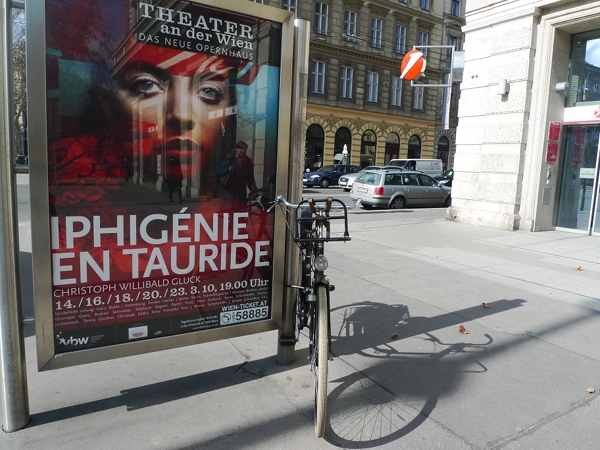 First stop: the bank, in the city center, a 25 minute ride away. To get here, Jacqueline rode back via the Danube Canal path, and then along the Ring Road - which is another "bicycle highway" that loops around the city center.
First stop: the bank, in the city center, a 25 minute ride away. To get here, Jacqueline rode back via the Danube Canal path, and then along the Ring Road - which is another "bicycle highway" that loops around the city center.
 Jacqueline then proceeded to the photo store in an adjacent district - a 15 minute ride away - to buy some film. She rode there mostly on the road, via a combination of bicycle lanes, "sharrow"-marked side streets, and unmarked side streets. The thing about "sharrows" in Vienna, is that they are mostly painted on 1-way streets against the flow of traffic. Yes, against. The speed limit on these streets is usually 30 km/h. This design goes against everything I have come to believe over the past year as a cyclist in Boston. What do you think of it? And could anybody comment whether Copenhagen and Amsterdam are the same in this respect?
Jacqueline then proceeded to the photo store in an adjacent district - a 15 minute ride away - to buy some film. She rode there mostly on the road, via a combination of bicycle lanes, "sharrow"-marked side streets, and unmarked side streets. The thing about "sharrows" in Vienna, is that they are mostly painted on 1-way streets against the flow of traffic. Yes, against. The speed limit on these streets is usually 30 km/h. This design goes against everything I have come to believe over the past year as a cyclist in Boston. What do you think of it? And could anybody comment whether Copenhagen and Amsterdam are the same in this respect?
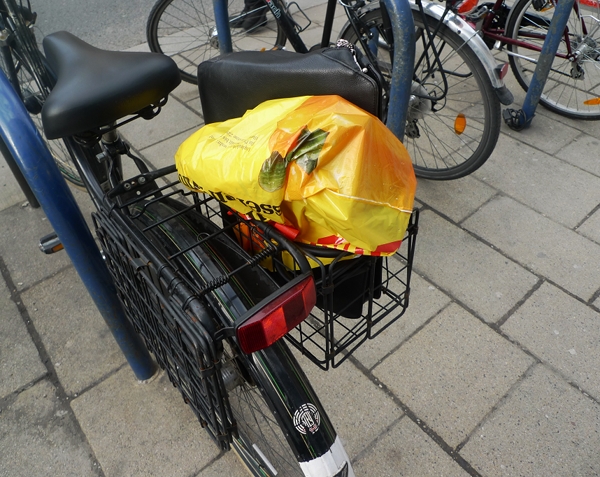 After the photo store, Jacqueline was locked up on a main shopping street and waited a bit while I met a friend for coffee. Then we went to the grocery store Billa.
After the photo store, Jacqueline was locked up on a main shopping street and waited a bit while I met a friend for coffee. Then we went to the grocery store Billa.
 Jacqueline was proud that she could fit 1/2 week's worth of groceries and my laptop bag into a single pannier. (She is lazy and did not want to open the second one.)
Jacqueline was proud that she could fit 1/2 week's worth of groceries and my laptop bag into a single pannier. (She is lazy and did not want to open the second one.)
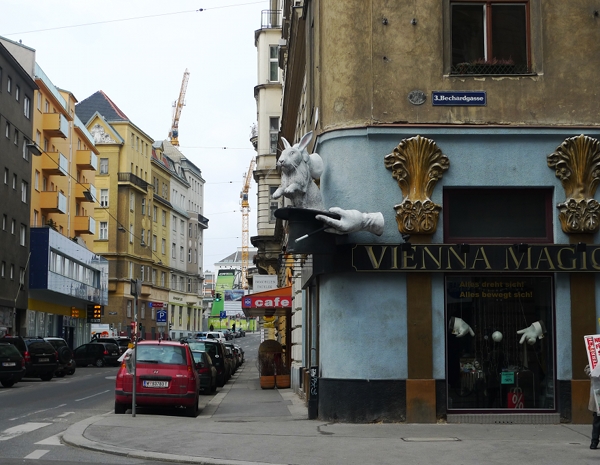 As dusk approached, we cycled home - once again via a combination of roads, then the Ring Path via the route described here. All in all, I would estimate that Jacqueline did a couple of hours of back and forth cycling, and this was typical of how much I travel through the city on an average day in Vienna. Normally all of these trips would have been done using public transport. The travel time by bike is about the same.
As dusk approached, we cycled home - once again via a combination of roads, then the Ring Path via the route described here. All in all, I would estimate that Jacqueline did a couple of hours of back and forth cycling, and this was typical of how much I travel through the city on an average day in Vienna. Normally all of these trips would have been done using public transport. The travel time by bike is about the same.
 I rode Jacqueline for transportation for the last week of my stay in Vienna. It was wonderful and made up for my bad luck earlier this month. I now feel like an idiot that I didn't just buy a bicycle when I lived here for longer stretches in previous years. Cycling in the countryside on my days off was nice, but I have to say that commuting by bike in Vienna is even nicer. And regardless of what the local shops might tell you, a 3-speed is sufficient to tackle "hilly Vienna". I am by no means in the best shape and had no trouble. Of course, the vintage magic of Jacqueline might play a role in that as well. But in any case - if you are in Vienna, get a bicycle and enjoy the city, whether you are a leisurely visitor or work at a fast-paced job!
I rode Jacqueline for transportation for the last week of my stay in Vienna. It was wonderful and made up for my bad luck earlier this month. I now feel like an idiot that I didn't just buy a bicycle when I lived here for longer stretches in previous years. Cycling in the countryside on my days off was nice, but I have to say that commuting by bike in Vienna is even nicer. And regardless of what the local shops might tell you, a 3-speed is sufficient to tackle "hilly Vienna". I am by no means in the best shape and had no trouble. Of course, the vintage magic of Jacqueline might play a role in that as well. But in any case - if you are in Vienna, get a bicycle and enjoy the city, whether you are a leisurely visitor or work at a fast-paced job!
 At 7:00 am, we are off to the office via the Danube Canal Path - which functions like a cross-town bicycle highway through Vienna. It just so happens that both my flat and my office are close to the canal, so our route to work is pretty straightforward. Pictured above is the nearest entrance onto the path.
At 7:00 am, we are off to the office via the Danube Canal Path - which functions like a cross-town bicycle highway through Vienna. It just so happens that both my flat and my office are close to the canal, so our route to work is pretty straightforward. Pictured above is the nearest entrance onto the path. The Danube Canal is an offshoot of the Danube River. Both the canal and the river proper have bicycle paths running alongside, but the advantage of he canal path is that it cuts through the center.
The Danube Canal is an offshoot of the Danube River. Both the canal and the river proper have bicycle paths running alongside, but the advantage of he canal path is that it cuts through the center. One thing I like about it, is how green the water looks - especially in the morning. No idea whether this is due to reflection from trees or chemical pollution, but it looks nice and so I choose to believe the former.
One thing I like about it, is how green the water looks - especially in the morning. No idea whether this is due to reflection from trees or chemical pollution, but it looks nice and so I choose to believe the former. There are some cobblestone stretches along the path, and the 28" Schwalbe Delta Cruisers on Jacqueline are just fine with them. But I have seen other cyclists get off their bikes and walk here.
There are some cobblestone stretches along the path, and the 28" Schwalbe Delta Cruisers on Jacqueline are just fine with them. But I have seen other cyclists get off their bikes and walk here. Some parts of the canal path are woodsy and surreal-looking.
Some parts of the canal path are woodsy and surreal-looking. Jacqueline enjoys this sort of scenery the most.
Jacqueline enjoys this sort of scenery the most. Other stretches are more urban and take you closer to the main road.
Other stretches are more urban and take you closer to the main road. That's okay too, but cycling here during rush hour will give you a nice helping of auto exhaust fumes. Have others noticed this problem in large cities? I have been told that automobile emissions in Europe (not counting former Eastern-bloc countries) are supposed to be less toxic than in the US, but my lungs seem to disagree. If anybody has more info about this, please share.
That's okay too, but cycling here during rush hour will give you a nice helping of auto exhaust fumes. Have others noticed this problem in large cities? I have been told that automobile emissions in Europe (not counting former Eastern-bloc countries) are supposed to be less toxic than in the US, but my lungs seem to disagree. If anybody has more info about this, please share. Heading toward the Southern edge of town, the scenery on the Danube Canal Path grows distinctly less picturesque. We are now cycling alongside the highway. And yes, that is a highway sign for Budapest and Bratislava. Bratislava (capital of Slovakia) is only a 45 minute drive away from this point. But instead of going there, Jacqueline heads to the office.
Heading toward the Southern edge of town, the scenery on the Danube Canal Path grows distinctly less picturesque. We are now cycling alongside the highway. And yes, that is a highway sign for Budapest and Bratislava. Bratislava (capital of Slovakia) is only a 45 minute drive away from this point. But instead of going there, Jacqueline heads to the office. The landscape around my place of work is somewhat post-apocalyptic, but over time I have grown fond of it. Lots of interesting research facilities there, and I work with nice people. The total time it takes Jacqueline to cycle to the office from our flat is 20 minutes - the exact time it takes to commute using public transport.
The landscape around my place of work is somewhat post-apocalyptic, but over time I have grown fond of it. Lots of interesting research facilities there, and I work with nice people. The total time it takes Jacqueline to cycle to the office from our flat is 20 minutes - the exact time it takes to commute using public transport. I rarely stay at the office all day, but typically have meetings all over the city. On this day I had an afternoon meeting in a Cafe at the end of the Prater - the largest park in Vienna.
I rarely stay at the office all day, but typically have meetings all over the city. On this day I had an afternoon meeting in a Cafe at the end of the Prater - the largest park in Vienna. Lusthaus Cafe. Before you misunderstand what I do for a living - it's not what is sounds like in English. The name means "funhouse". This was about a 10 minute ride from the office for Jacqueline. After the meeting, we briefly returned to work, leaving in the late afternoon to run some errands.
Lusthaus Cafe. Before you misunderstand what I do for a living - it's not what is sounds like in English. The name means "funhouse". This was about a 10 minute ride from the office for Jacqueline. After the meeting, we briefly returned to work, leaving in the late afternoon to run some errands. First stop: the bank, in the city center, a 25 minute ride away. To get here, Jacqueline rode back via the Danube Canal path, and then along the Ring Road - which is another "bicycle highway" that loops around the city center.
First stop: the bank, in the city center, a 25 minute ride away. To get here, Jacqueline rode back via the Danube Canal path, and then along the Ring Road - which is another "bicycle highway" that loops around the city center. Jacqueline then proceeded to the photo store in an adjacent district - a 15 minute ride away - to buy some film. She rode there mostly on the road, via a combination of bicycle lanes, "sharrow"-marked side streets, and unmarked side streets. The thing about "sharrows" in Vienna, is that they are mostly painted on 1-way streets against the flow of traffic. Yes, against. The speed limit on these streets is usually 30 km/h. This design goes against everything I have come to believe over the past year as a cyclist in Boston. What do you think of it? And could anybody comment whether Copenhagen and Amsterdam are the same in this respect?
Jacqueline then proceeded to the photo store in an adjacent district - a 15 minute ride away - to buy some film. She rode there mostly on the road, via a combination of bicycle lanes, "sharrow"-marked side streets, and unmarked side streets. The thing about "sharrows" in Vienna, is that they are mostly painted on 1-way streets against the flow of traffic. Yes, against. The speed limit on these streets is usually 30 km/h. This design goes against everything I have come to believe over the past year as a cyclist in Boston. What do you think of it? And could anybody comment whether Copenhagen and Amsterdam are the same in this respect? After the photo store, Jacqueline was locked up on a main shopping street and waited a bit while I met a friend for coffee. Then we went to the grocery store Billa.
After the photo store, Jacqueline was locked up on a main shopping street and waited a bit while I met a friend for coffee. Then we went to the grocery store Billa. Jacqueline was proud that she could fit 1/2 week's worth of groceries and my laptop bag into a single pannier. (She is lazy and did not want to open the second one.)
Jacqueline was proud that she could fit 1/2 week's worth of groceries and my laptop bag into a single pannier. (She is lazy and did not want to open the second one.) As dusk approached, we cycled home - once again via a combination of roads, then the Ring Path via the route described here. All in all, I would estimate that Jacqueline did a couple of hours of back and forth cycling, and this was typical of how much I travel through the city on an average day in Vienna. Normally all of these trips would have been done using public transport. The travel time by bike is about the same.
As dusk approached, we cycled home - once again via a combination of roads, then the Ring Path via the route described here. All in all, I would estimate that Jacqueline did a couple of hours of back and forth cycling, and this was typical of how much I travel through the city on an average day in Vienna. Normally all of these trips would have been done using public transport. The travel time by bike is about the same. I rode Jacqueline for transportation for the last week of my stay in Vienna. It was wonderful and made up for my bad luck earlier this month. I now feel like an idiot that I didn't just buy a bicycle when I lived here for longer stretches in previous years. Cycling in the countryside on my days off was nice, but I have to say that commuting by bike in Vienna is even nicer. And regardless of what the local shops might tell you, a 3-speed is sufficient to tackle "hilly Vienna". I am by no means in the best shape and had no trouble. Of course, the vintage magic of Jacqueline might play a role in that as well. But in any case - if you are in Vienna, get a bicycle and enjoy the city, whether you are a leisurely visitor or work at a fast-paced job!
I rode Jacqueline for transportation for the last week of my stay in Vienna. It was wonderful and made up for my bad luck earlier this month. I now feel like an idiot that I didn't just buy a bicycle when I lived here for longer stretches in previous years. Cycling in the countryside on my days off was nice, but I have to say that commuting by bike in Vienna is even nicer. And regardless of what the local shops might tell you, a 3-speed is sufficient to tackle "hilly Vienna". I am by no means in the best shape and had no trouble. Of course, the vintage magic of Jacqueline might play a role in that as well. But in any case - if you are in Vienna, get a bicycle and enjoy the city, whether you are a leisurely visitor or work at a fast-paced job!

This almost makes me want to trade in the country life for the city life. I do miss it sometimes. Interesting about the green water. All of the lakes, ponds, rivers, creeks and streams around here are that same color! I had never seen it before moving here (northeast TN), even when I lived just over the mountains in western NC. I've lived mostly along the east coast, from Richmond on up, and all the water there is brown. I have no clue what causes it, but it is apparently perfectly harmless to swim in, and lovely to look at.
ReplyDeleteI'll ask about the sharrows on one way streets. Did you see bicyclists riding in both directions, or only following the sharrows against motor traffic?
ReplyDeleteI can only guess that I've read that many German one way streets have signs allowing 2 way bicycle traffic. In this case, with a speed limit of 19mph/30kmh, it may be considered obvious with no need to indicate that bicyclists can ride in the normal direction, and the sharrow is there to indicate that on low traffic streets, bicyclists are allowed to ride in the opposite direction too.
Fun and interesting post! I had to back up to catch the "Lusthaus" but when I did... LOL.
ReplyDeleteI'm curious about the prevalence of bike theft in Vienna. I noticed you locked Ms. Jacqueline on your stops. When in Belgium this year, I was amazed at how many cycles spent the night outside locked only by the rear wheel locking mechanism.
Mike - Many people I know have complained about bike theft in Vienna. At first this made me assume that bike theft was a serious problem here. But at some point it occurred to me to ask whether they locked their bikes. Turns out no - My friends/acquaintances were complaining about their unlocked bikes getting stolen. In my book this makes Vienna a pretty safe place for bikes: Here, either a cable lock or a wheel lock will prevent theft in most cases, whereas in American urban areas these are not sufficient. As for why the wheel lock works in Europe - I think it is mostly a matter of vans being less common. In order to steel a bike with a locked wheel, the thief would have to lift it and place it into a van or truck.
ReplyDeleteStephen - There are always a few stray individuals cycling the wrong way everywhere (i.e. even on opposite sides of 2-way streets), but no overall I did not see cyclists going with traffic on the roads with the "wrong way sharrows". I know what you're talking about, where some 1-way streets have signs allowing 2-way bike traffic, and those exist in Vienna as well (ex: Neubaugasse). But the streets I am talking about seem to specifically instruct cyclists to only go opposite of traffic.
I know David Hembrow did a post about permeability and one-way streets in Assen, but I don't know why the bikes would only go against the traffic. I know here in the UK that one-way systems tend to be designed to funnel traffic onto the bigger roads so if it's the same in Vienna, that might explain why most cyclists were swimming against the stream, as it were.
ReplyDeleteTravelling against the flow of motorised traffic ('officialy' established/set that is!), contributes more to bicyclists' safety. They could (probably) take 'evasive' action when an errant motorist(usually 'marinated' in alcohol or with blood charged with drugs ;D) strays into their 'lane'. In such lanes motorists have the 'understanding' not to 'intrude' the particular lane except in an 'emergency' or 'when the coast is clear within sight'.
ReplyDeleteHowever, one is advised to strictly abide by the 'official' direction of travel in 'bicycle lanes'!
Lem
Lem - Yes, what you are describing seems to be the idea behind the design. It seems to work for Vienna; I just really needed to switch from my Boston "VC" mode in order to willingly cycle down a wrong way street. In general, I understand the concept behind Vienna's cycling infrastructure design much better now than when I first rode here, and have more appreciation for it. If you like, you can get around the city entirely as a vehicular cyclist, you just need to know which routes are designed for that and which are not. Conversely, if you prefer, you can get around the city entirely via its network of "we'll take you by the hand" bicycle paths, lanes, and side-street sharrows - again, you just need to know the appropriate routes. It is an interesting system and not as limiting as I thought when I initially cycled there.
ReplyDeleteLovely post. The cycle path is so pretty.
ReplyDeleteViz auto exhaust. It's pretty foul on truck routes here, but otherwise I don't smell it. It's incredibly depressing when I do, though. I know the air is polluted, but it really is awful to experience it so viscerally.
I check in here often to see your lovely photos and read your interesting descriptions. But I LOVE this third-person narrative from your bicycle's point of view. Brilliant!!
ReplyDeleteThe official rule in Holland is that one-way streets are one-way for all vehicles including bicycles, but you would be hard pressed to find a one-way street without the reassuring subsign "Uitgezonderd rijwielen" (pronounced "behalve fietsen" - we have our fair share of Amtsdeutsch too) meaning "except bicycles". As a result, one-way streets always have bike traffic in both directions and there is no need for additional signs or markings. You might say that the general rule is that there are no rules for cyclists; visit Amsterdam and find out for yourself - or read Henry Cutler's recent brush with the law.
ReplyDeleteFrits - I have been to Amsterdam, but sadly it was before my bicycle awakening. I do remember lots of bicycles being there, but not the details of what they were doing. The way I understand it, in Vienna cycling rules are like this: On roads where there is no infrastructure, bicycles operate as vehicles. On roads where there is infrastructure, bicycles may only operate according to the infrastructure provided. This means that if there is a traffic-separated bicycle path, a bicycle may only ride on that path and not on the road with cars. If there is a bike lane, a bicycle may only ride in the bike lane and not in the regular lanes with cars. And if there are clearly designated "sharrow" markings with arrows, a bicycle must follow those signs. If I am wrong about this, I welcome a local to correct me, but this is how I understand the rules. And yes, the rules are mostly followed here.
ReplyDeleteyou're probably right about the traffic pollution in europe, it'll be due to the vast number of diseal fuelled cars:
ReplyDeleteSee this blog for more
http://crapwalthamforest.blogspot.com/2010/03/car-sick-cycling-hostile-toxic-london.html
"London is the most polluted capital in Europe when it comes to nitrogen dioxide, which is increasingly believed to be a cause of the asthma epidemic which now affects one in seven children in Britain.
Ironically, the high pollution levels are largely due to a rapid rise in the number of diesel cars – they have increased from about 8 per cent of new ones two decades ago to around 30 per cent now – which have been heavily marketed as relatively clean."
regarding vehicle emissions in europe versus US, it's not an easy comparison. the US used to have more stringent standards throughout the 80s and 90s than anywhere in the world, but most western countries more or less caught up with us. the EU standards now are about on a par, but with higher standards for CO2 output and lower standards for particulate output (which is *partly* why diesels are hard to market in the US). i think also that new trucks in the EU are subject to more stringent standards than in the US.
ReplyDeletei'm not sure about vienna, but i wonder if part of the reason you observe the pollution has to do with atmospheric inversion? just a guess, i really don't know much about it, other than some US cities like LA experience it, and it causes the smog to stay low as oppose to disperse higher up into the atmosphere.
oh, and i remember traveling through austria about 15 years ago and remembering how green the danube looked!
ReplyDeleteFashion/Technical question. What brand of folding baskets does Jacqueline have? They look larger than the Wald folding baskets that I use.
ReplyDeleteAaron
Fantastic travelogue. Jacqueline really gets around ;) There's some really scenic areas there. The path by the highway is not as nice, but it's cool that there IS a path by the highway. Sharrows going against traffic sounds like a nightmare; I don't like the sound of that at all, though I'd be interested to try it once.
ReplyDeleteDo you find it very different from Boston?
Well I know what to expect if ever I am in Vienna and bicycling!
ReplyDeleteI loved this post. Then again, I always enjoy reading of your velocipedic adventures.
ReplyDeleteI've seen the green tint you described in many urban canals. It may have to do with chemical pollution but, as I understand, it also has to do with the nearly unchecked algae growth that occurs in those bodies of water, which don't have the cross-currents and animal life of the rivers, lakes and bays into which the canals feed.
Ironically, canals with high levels of boat traffic have less pollution and algae growth--and are less likely to have that green tint. It seems that plying barges and ships provide some of the cross-currents and aeration that prevents unchecked algae growth in bodies of water that naturally have currents.
Those bicycle paths look fantastic—we have no serious bike paths on my side of Washington, DC (and DC bike lanes are really a joke—traffic is bad enough that as we clamor for higher capacity for cars we make traffic worse).
ReplyDeleteDC did put in a contraflow bike lane on 15th St NW last year and it scares the hell out of me. I've ridden it a few times and now I just ride with auto traffic on 14th or 16th. What I worry about are turning cars…because the bike lane is segregated from auto traffic by a parking lane. I mean, when I drive down that street and make a left will I be looking at the bike lane? Come on!
DC has an interesting debate that has been going on about one of our main east-west routes. With the construction of a busway (hopefully to be upgraded to trams in the next 10 to 15 years) they have talked about putting in bike lanes. This has caused huge problems due to demand for auto capacity (and we know the reality of higher auto capacity—worse traffic because of lack of incentives to use other forms of transit/routes)—and has pointed out the problems with development policy (many delivery alleys were built over when blocks were redeveloped in the 70's and 80's, which is why we have so many curb lanes [and potentially bike lanes] blocked with delivery trucks). Basically it is a mess and there is no push to have a comprehensive bike traffic regime here.
Also, Love the Blog!
It's interesting about diesel cars; I've never understood why they are marketed as relatively clean. Also interesting about boat traffic preventing algae accumulation. The cause and effect of various factors in the environment is never straightforward, which is why I tend to be cautious about being vehemently for or against something when it comes to these issues.
ReplyDeleteDottie - The main difference (as I see it) between Vienna and Boston, is that in Vienna a cyclist can choose to travel to almost any destination within the city using the path&lane network (with almost no vehicular cycling at all, except for a block here and there down very quiet side streets). This requires knowing which streets have the infrastructure and which don't, but there is a handy website that helps with that - basically mapping out your route for you and even indicating which stretches of the route are segregated paths, which are lanes, etc. In Boston, it is simply not possible to get around from point A to point B without at some point cycling on busy roads with cars. Yes, there is the river trail and some streets have bike lanes - but the design does not even begin to approach the full coverage of Vienna's network. This is not to say that I think paths are good and VC is bad - just an objective description of the situation. Vienna does make it possible to move around the city as a vehicular cyclist, contrary to what I initially thought - you just need to know the routes to take. So it essentially gives you a choice between routes with infrastructure and routes without. Boston does not.
ReplyDeleteAaron - I assumed the basket panniers were Wald, but I will check with the owner.
Automobile emissions less toxic in europe, thats right, but scientists found out, that you wouldnt smell it in the car, cause the cage in the car is full of toxic air.
ReplyDeletethe differences on a bike is, that you get fresh air added, thats why you smell the cars more on the bike than in a car.
And when all air is with big quantity of toxic emissions, than you wouldnt smell it even on a bicycle, and thats really bad then.
In fact car drivers are after about 15, 20 minutes on drugs,if they in traffic jams, cause they get no fresh air in their cage.
scary
I suppose Diesels are 'cleaner' because of their lower fuel consumption - our conventional hatchback, which isn't the smallest car available by any means and seats 5 adults, albeit snugly - regularly gets 68-74 MPG (those are imperial gallons, so slightly larger than their US equivalent). Getting that sort of mileage in a petrol car would require a hybrid. On the down side is the particulate emissions, which are bad for peoples' lungs when trapped in narrow city streets. So good for the climate, but bad pollution by other measures. We don't do much town driving so we reckoned it was worth the tradeoff.
ReplyDeletetownmouse - This makes sense given how I feel when cycling next to the freeway in Vienna. After experiencing it a couple of times, I now avoid those areas, especially at rush-hour times.
ReplyDeleteHoefi - I have read about that too. But doesn't the inside of the car get the air filtered in some way via the heating/ac/airflow system, if the windows are kept closed?
Velouria,
ReplyDeleteWhat the hardcore VC doesn't seem to understand is that VC is really stressful for most people, even when it is safe and efficient. I don't "have a problem" cycling anywhere in Boston -- I will ride on almost any road. Despite this, I love, love, love segregated bike paths. They are much more relaxing and pleasant.
Giffen - I agree to some extent. But I think that segregated paths need to be treated with caution, and the feeling of stress-free safety they lull the cyclist into is one reason for that. One must be extremely careful at intersections and one must cycle very slowly, and then the paths are great. The problem is that people sometimes attempt to cycle on them at similar speeds as on the road and to ignore intersections, and this leads to trouble. Another source of irritation for some, is that paths usually lengthen the route from A to B considerably compared to vehicular cycling. For those who have busy workdays with lots of places to be during the day, this can be a major downside.
ReplyDelete@velouria
ReplyDeleteyes the filter (with closed windows) does filter toxic out the inside air, but after a delay of about 15 minues you have all the toxic in the car again, then filter is worthless and doesn´t have the effect the producer want tell you.
it was a proove with and without filter.